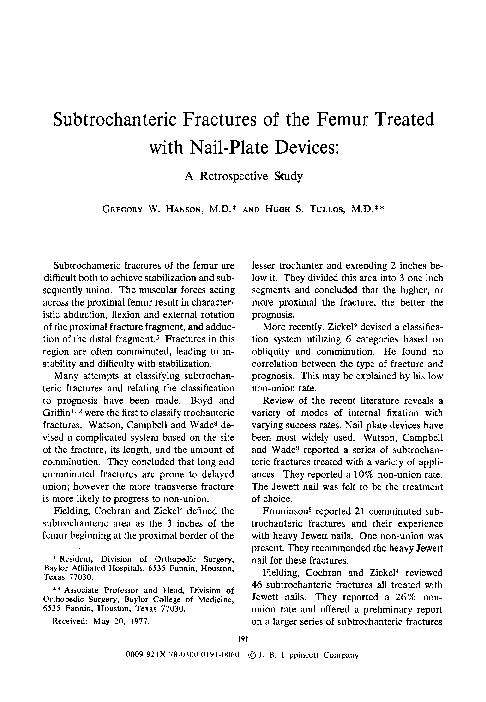Academia.edu no longer supports Internet Explorer.
To browse Academia.edu and the wider internet faster and more securely, please take a few seconds to upgrade your browser.
Subtrochanteric Fractures of the Femur Treated with Nail-Plate Devices
Subtrochanteric Fractures of the Femur Treated with Nail-Plate Devices
1978, Clinical Orthopaedics and Related Research
Related Papers
Injury-international Journal of The Care of The Injured
Subtrochanteric fracture: fixation using the AO tibial nail1992 •
2014 •
IP innovative publication pvt. ltd
Study on functional outcome of subtrochanteric femur fractures treated with proximal femoral nailIntroduction: The difficult nature of treating subtrochanteric fracture stems in part from the fact that this injury pattern is anatomically distinct from other proximal femoral peritrochanteric fractures and also from the femoral shaft fractures. The present study was made attempt to evaluate the functional outcome of subtrochanteric femur fractures treated with proximal femoral nail. Materials and Methods: The present study conducted on subtrochanteric femur fracture cases admitted in GSL medical college and general hospital, Rajahmundry during December 2013 to July 2015. Ethical Committee Clearance was obtained before beginning of the study. All patients were maintained on traction before surgery. All surgeries were done under spinal or epidural anaesthesia, low molecular weight heparin prophylaxis is given subcutaneously for the high risk patients during the hospitalization. Result: Majority of the cases were due to high energy trauma of Road traffic Accidents involving relatively younger patients. The operating time for 72% cases was between 1 to 2 hours. Operating time decreased with increasing familiarity of the implant system. The average length of Hospital stay was 17.6 days. At the end of five months, all except three patients could mobilise independently without any aid. According to harris hip score, 3 (12%) patients had excellent outcome, 18 (72%) patients had good outcome and 4 (16%) patients had fair outcome. Conclusion: In conclusion, Proximal femoral nail is a good implant for subtrochanteric fracture of the femur. The advantages are minimal exposure (closed technique), better stability and early mobilisation. Fractures united in all cases and postoperative functional outcome was satisfactory.
2006 •
Archives of Orthopaedic and Trauma Surgery
Long gamma nail in the treatment of subtrochanteric fractures2004 •
IP innovative publication pvt. ltd
Proximal femoral nailing in the management of subtrochanteric fractures of femur in adultsIntroduction: The proximal femoral nail (PFN) used as an intramedullary device for the treatment of fractures. Objectives: Study was taken to analyse the union of the subtrochanteric fracture, internally fixed with PFN. Materials and Methods: Study was conducted in the department of orthopaedics, GSL Medical College. Individuals with acute subtrochanteric femur fractures >18 years were included in the study. The patient was positioned supine on the fracture table under spinal or epidural or general anesthesia as the condition of the patient permitted. Pre-operatively one dose of antibiotic was also administered. The fracture was reduced by longitudinal traction on fracture table and the limb was placed in neutral or slight adduction to facilitate nail insertion through the greater trochanter ; P <0.05 was considered statistically significant. Results: At the end of five months, all except three patients could mobilise independently; statistically there was significant difference (P<0.05). Based on Harris Hip score obtained 3 patients outcome was excellent, 18 patients were good and 4 patients had fair outcome. Conclusion: Minimal exposure, better stability and early mobilization are the advantages with PFN. Fractures united in all cases and postoperative functional outcome was satisfactory. PFN could be a preferred implant of choice in treating subtrochanteric fractures especially in elderly.
RELATED PAPERS
International Journal of Environment and Climate Change
Ecological Risk Assessment of Oil Spill Events Using a Coupled Geospatial and Weight of Evidence Data-Process Model2013 •
Medical Teacher
E-learning and deliberate practice for oral case presentation skills: A randomized trial2012 •
Pasado abierto. Revista del Centro de Estudios Históricos (CEHis) de la Facultad de Humanidades de la Universidad Nacional de Mar del Plata.
¿Cómo modulan los afectos la puesta en acto de las políticas de género en las Universidades? Una aproximación a partir de los casos de la Universidad Nacional de San Martín (UNSAM) y la Universidad Nacional de Avellaneda (UNDAV)2023 •
16 de Abril
Modelo de gestión genético transformacional: aproximación a las instituciones universitarias2015 •
Değerler Eğitimi Dergisi
Din Eğitiminin Bilimler Arasındaki Konumu: James Michael Lee’nin Din Öğretimi Yaklaşımı Bağlamında Bir İnceleme2021 •
Register: jurnal ilmiah teknologi sistem informasi
Identifying Degree-of-Concern on COVID-19 topics with text classification of Twitters2021 •
Proceedings of Meetings on Acoustics
Filtered sound – The impact of aerosol filters on the sound of brass instruments
 Jef Michielsen
Jef Michielsen